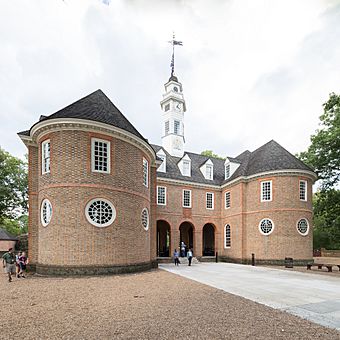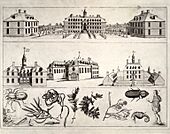Capitol (Williamsburg, Virginia) facts for kids
Quick facts for kids |
|
|
Capitol
|
|
|
U.S. National Historic Landmark District
Contributing Property |
|

Reconstruction of the first Capitol at Williamsburg
|
|
| Lua error in Module:Location_map at line 420: attempt to index field 'wikibase' (a nil value). | |
| Location | Williamsburg, Virginia |
|---|---|
| Built | 1934, based on 1705 original |
| Architectural style | Colonial Revival |
| Part of | Williamsburg Historic District (ID66000925) |
| Added to NRHP | October 15, 1966 |
The Capitol building in Williamsburg, Virginia, was a very important place. It was where the government of the colony of Virginia met. From 1705 to 1780, lawmakers gathered here to make decisions.
This building housed both parts of Virginia's government: the Virginia General Assembly and the Governor's Council. It was like the state capitol building we have today. The capital moved from Jamestown to Williamsburg in 1699. Later, in 1780, the capital moved again to Richmond.
Two different Capitol buildings stood on this same spot. The first one was used from 1705 until it burned down in 1747. The second Capitol was built in 1753 and served until 1780. Today, you can visit a reconstructed version of the first Capitol. It was rebuilt in the 1930s as part of Colonial Williamsburg.
Contents
The Williamsburg Capitol: A Place of Power
The First Capitol Building (1705–1747)
In 1698, the original Capitol building in Jamestown, Virginia, caught fire and was destroyed. After this, Virginia's leaders decided to move the capital. They wanted a new location away from the marshy areas of Jamestown.
A new and better Capitol building was constructed in Williamsburg. A builder named Henry Cary oversaw the project. Construction began in 1701 and finished in 1705. However, the lawmakers started using the building in 1704. A few years later, in 1714, the Governor's Palace was built nearby.
The first Capitol had a unique "H" shape. It was like two separate buildings connected by an open walkway. Each side was for a different part of the government. One side was for the General Court and the colony's secretary. The other side was for the House of Burgesses, where elected representatives met. To prevent fires, the first Capitol was built without fireplaces. But later, chimneys were added in 1723 to help keep the building dry. Sadly, on January 30, 1747, the building burned down, leaving only some walls and the foundation.
The Second Capitol Building (1753–1779)
After the first Capitol burned, Governor William Gooch wanted it rebuilt. But some lawmakers thought the government should move to a city closer to trade routes. While they debated, the lawmakers met in the Wren Building at the College of William and Mary.
Finally, in November 1748, they voted to rebuild the Capitol. The decision was very close, with only two votes making the difference! The new building was finished, and lawmakers met there for the first time on November 1, 1753.
This second Capitol building saw many important moments in American history. On May 29, 1765, Patrick Henry gave a famous speech here against the Stamp Act. Other important leaders like George Washington, George Mason, Thomas Jefferson, and Richard Henry Lee also worked in this building. They helped lead the way to the American Revolution.
As fighting began in the northern colonies, discussions in this Capitol led to big changes. Lawmakers talked about Mason's Virginia Declaration of Rights and Virginia's first constitution. They also discussed Jefferson's ideas for religious freedom.
On June 29, 1776, Virginians declared their independence from Great Britain. They wrote their own state constitution. This happened four days before the Declaration of Independence was approved in Philadelphia on July 4.
The Capitol in Williamsburg was used until the American Revolutionary War was underway. Governor Thomas Jefferson suggested moving the capital to Richmond. The building was last used as a capitol on December 24, 1779. The Virginia General Assembly then moved to Richmond in 1780.
After the capital moved, the old Capitol building was used for different things. It served as a court and even a school. Around 1800, one side of the building was removed because it was unsafe. The other side stood until it was destroyed by fire in 1832. After that, no part of the original buildings remained.
Rebuilding the Capitol
The building you see in Colonial Williamsburg today is the third Capitol on that site. In the early 1900s, a minister named Dr. W. A. R. Goodwin worked to restore historic Bruton Parish Church. He dreamed of restoring other old buildings in Williamsburg. His dream came true when he partnered with John D. Rockefeller Jr., a wealthy businessman. Together, they created Colonial Williamsburg.
The reconstructed Capitol, along with the Governor's Palace and the Wren Building, are key parts of this restoration. Architects decided to rebuild the first Capitol building. They had better old drawings and documents for its design, including the Bodleian Plate found in 1929. This made it easier to recreate accurately.
Some historians later found that parts of the reconstruction, especially the foundations, were a bit guessed. They were based more on modern ideas than on exact old evidence. However, the reconstructed Capitol is now seen as an important example of Colonial Revival architecture. It shows how people in the 1930s imagined colonial buildings.
The reconstructed Capitol opened to visitors on February 24, 1934.
Gallery
-
A reconstructed room where the House of Burgesses met.
See also
- Virginia State Capitol (Richmond)






